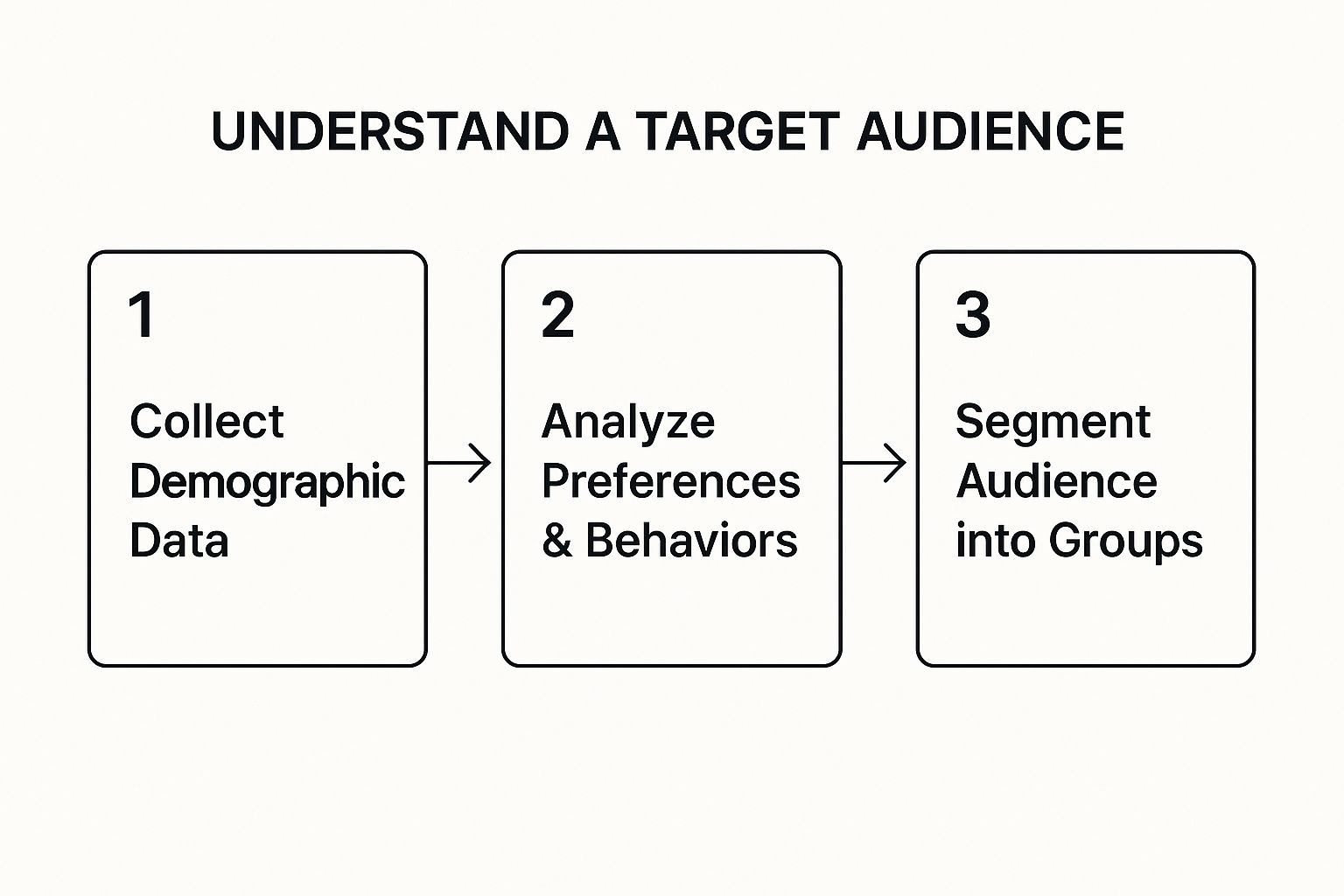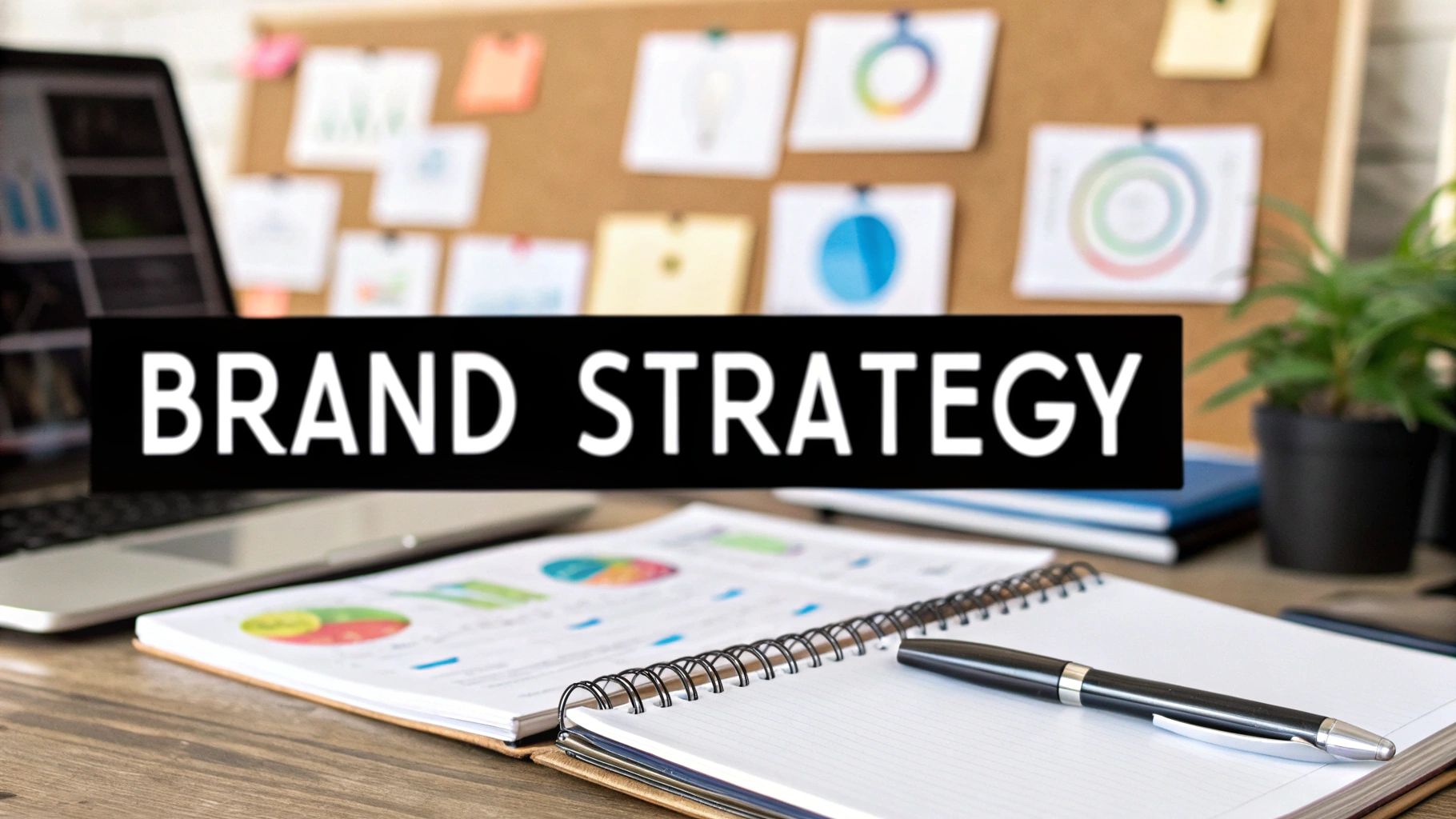Let's get one thing straight: your brand strategy isn't just a marketing exercise. It’s the long-term game plan for how your business connects with real people. It's the blueprint that dictates how you communicate, what you stand for, and the gut feeling you leave with every single customer. This guide will show you how to build that blueprint, piece by piece.
Your Foundation for a Powerful Brand Strategy

Building a brand that people actually remember means creating an experience that sticks. It’s so much more than a slick logo or a clever tagline. Your brand strategy is the single most important asset you have for long-term growth, acting as the true north for every decision you make.
I like to put it this way: a logo is just a picture, but a brand is a story. Your strategy is the plot that makes that story worth telling.
The Essential Pieces of a Strong Brand
So, what goes into a great brand strategy? It’s not a list of abstract buzzwords. These are the functional parts that make unforgettable brands tick, working together to create a presence that feels both powerful and authentic.
Let's break down the core components you need to get right.
| Core Components of a Brand Strategy || :--- | :--- | :--- || Component | What It Is | Why It Matters || Purpose | Your reason for being, beyond just turning a profit. It’s your “why.” | A clear purpose pulls in customers who believe what you believe. || Consistency | The same look, feel, and voice across every single touchpoint. | Consistency builds familiarity and, more importantly, trust. || Emotional Connection | The ability to make people feel something about your brand. | People don’t just buy products; they buy into a mission. This turns customers into fans. |
Getting these elements to work in harmony is what separates the memorable brands from the forgettable ones.
This isn't just theory—it has a real impact on the bottom line. Research shows that companies with strong, consistent branding achieve growth rates 24% faster than their competitors. What's more, a staggering 78% of businesses say that consistent branding is the key to better customer retention.
A brand strategy isn't something that lives only in the marketing department. It's a company-wide commitment that should align everything from product development and sales to customer service and internal culture.
Why This Is Your Most Important Blueprint
Without a clear strategy, your branding efforts will feel random and disconnected. You might have a great-looking website and a busy social media feed, but if they aren't telling the same core story, you're leaving money on the table and failing to build real brand equity.
A solid strategy prevents that chaos. It gives everyone in your organization—from the CEO to the newest hire—a clear set of directions. It ensures every new product launch, marketing campaign, and customer support ticket reinforces who you are and what you promise.
To see how all these pieces come together in a full-blown plan, you’ll find a ton of value in learning how to build a brand strategy from start to finish. Think of this as the foundational knowledge you need before we dive into the practical steps ahead.
Uncover Your Brand's DNA Through Deep Research
Before you can even think about logos or taglines, you have to do the homework. A brand that truly connects with people isn’t built on guesswork; it's built on a deep understanding of the world it's about to enter. This is the foundation.
Think of it as the investigative phase. Skipping this step is like building a house on sand. You need to dig deep to find the solid ground—the insights about your market, your customers, and your own business—that will support every decision you make from here on out.
Go Beyond Surface-Level Competitor Analysis
It’s easy to fall into the trap of just listing your competitors' features and pricing. That’s a start, but it’s not where the magic happens. The real goal is to find the gaps they’ve left open. I'm not just talking about a missing product feature, but the emotional needs and service expectations they aren't meeting.
To do this, you have to ask better questions:
- What story are they telling? Dive into their website, their social media feeds, their ads. What promise are they making, implicitly or explicitly?
- How do their customers really feel? Don't just glance at star ratings. Read the one-star and five-star reviews on G2 or Capterra. Scour Reddit threads and forum discussions. Customer frustrations are goldmines for opportunity.
- Where are they inconsistent? Maybe their marketing screams "premium," but their customer service reviews tell a story of long wait times and unhelpful reps. That’s a crack in their brand armor.
This mindset shifts your analysis from "what they sell" to "who they are" to their audience. For a more detailed look at this process, our guide on branding market research offers real strategies for growth is a great resource.
Craft Customer Personas That Feel Real
Here's a hard truth: if you try to speak to everyone, you'll end up connecting with no one. This is where customer personas come in, but they need to be more than just a PowerPoint slide with a stock photo and some demographic data. A great persona should feel like a real person you know.
Give them a name, a job, and a bit of a backstory. Most importantly, get to the heart of their motivations and what keeps them up at night, specifically in relation to what you do.
A persona isn't just a demographic summary; it's a character study. You should know what keeps them up at night and what would make their day easier. This empathy is the secret to creating a brand that truly resonates.
For instance, "Male, 30-40, interested in tech" is useless. But "Alex, a 34-year-old project manager" is a start. Let's make him real: He's constantly overwhelmed by clunky software and has a deep-seated fear of missing a critical deadline. He isn't just buying a tool; he's buying confidence and control. Now that's someone you can talk to.
Conduct an Honest Internal Audit
Finally, it's time to look in the mirror. A brand can't make promises that the business can't deliver on. An internal audit is about aligning the brand you want to be with the company you actually are. Brutal honesty is non-negotiable here.
Get your team in a room—not just leadership—and hash out the tough questions:
- What do we do better than anyone else? Be specific. This isn't about ego; it's about identifying your core competency.
- Where are we consistently falling short? Acknowledging your weaknesses is a strength. It stops you from making promises you can't keep.
- What principles will we never, ever compromise on? These are your brand values. They are the bedrock of your purpose.
This self-awareness is absolutely crucial. As research from Harvard Business School points out, brand equity is built when a brand's image not only connects with customers but also genuinely reflects what the company stands for. This audit ensures the brand you build is authentic from the inside out.
Define Your Brand Position and Core Message
You’ve done the digging and the research is solid. Now it’s time to switch gears from understanding the market to actually carving out your place in it. This is where you stop analyzing and start acting, turning all that data into a compelling story that makes you stand out. It’s time to plant your flag.
Your brand positioning is essentially your stake in the ground. It’s a sharp, clear statement that answers one crucial question for your audience: “With all the choices out there, why should I pick you?” It's the sweet spot where your audience's needs, your competitors' gaps, and your own unique strengths all meet.
Articulating Your Purpose and Mission
Before you write a single headline or social media post, you have to get crystal clear on your "Why." This isn't just corporate fluff; it's the fundamental belief that fuels your business. Your purpose is the reason you exist beyond just making a profit. Your mission is what you do every day to make that purpose a reality, and your vision is the future you hope to create.
Here’s a simple way to think about it:
- Purpose (The Why): To empower small businesses with accessible design.
- Mission (The How): By providing high-quality, handcrafted brand identities quickly and affordably.
- Vision (The What): A world where every great idea has a professional brand to match.
These statements act as your internal compass, guiding every decision and keeping your team aligned. They are the bedrock of a brand people can connect with on a much deeper, more emotional level. If you need some inspiration, checking out well-crafted brand positioning statement examples can inspire your own brand.
This infographic shows the basic flow for getting a handle on the audience you're trying to reach.

As the graphic illustrates, there’s a clear path from gathering raw data to building meaningful audience segments that will shape everything you say.
Building a Practical Messaging Framework
With your positioning nailed down, the next step is to translate those big ideas into the actual words you’ll use every day. A solid messaging framework ensures you sound like the same brand everywhere, from your website copy to a quick tweet.
Your unique value proposition (UVP) is the star of the show here. It's a single, powerful statement that screams the main benefit you offer. Think about Slack. Their UVP isn't "we're a chat app," but rather, "Slack is where work happens." See the difference?
Next up is your brand voice. Are you a knowledgeable authority? Or are you a witty, casual friend? This isn't about your personal preference; it's about what will genuinely connect with the audience you defined earlier.
A brand's message isn't just what it says, but how it says it. Your voice is the personality that makes your brand feel human and relatable, building the trust that is essential for customer loyalty.
And that trust is everything. In fact, 81% of consumers say that trusting a brand is a make-or-break factor in their buying decisions. That trust is built on consistency, which all comes back to how your brand speaks and shows up.
Your framework should also map out key talking points. These are short, memorable phrases that highlight your core benefits. They become the go-to soundbites for your marketing materials, sales pitches, and press releases, making sure everyone on your team is telling the exact same compelling story.
Craft Your Visual and Verbal Brand Identity

Alright, now for the fun part. This is where all that abstract strategy work—the research, the positioning, the soul-searching—starts to become real. We're about to give your brand a face and a voice, turning its core message into something people can actually see, hear, and connect with.
Think of it this way: your visual identity is like the clothes your brand wears. It’s the first impression, the thing that communicates your personality before you even open your mouth. It isn't just about making things look pretty; it's about choosing a look that feels right for who you are and speaks directly to the audience you've worked so hard to understand.
Designing Your Visual System
A great visual identity is way more than just a logo. It’s a complete system of design elements that all work together, creating a consistent look and feel everywhere your brand shows up. Cohesion is the name of the game.
Here are the non-negotiables you need to lock down:
- Logo: This is your brand's unique signature. Keep it simple, memorable, and make sure it’s versatile enough to look great whether it's on a giant billboard or a tiny favicon.
- Color Palette: Colors trigger emotions. You need to choose a primary and secondary palette that mirrors your brand's personality. Think about how blues can convey trust and stability, while a splash of yellow brings optimism and energy.
- Typography: The fonts you pick say a ton about you. A clean, modern sans-serif might scream "tech startup," whereas a classic serif can suggest a brand rooted in tradition and authority.
When these pieces work in harmony, they create a powerful visual language. A well-designed system doesn't just make your brand recognizable; it makes it feel professional and trustworthy.
Your visual identity should be a direct reflection of your brand's core values. It’s not about chasing the latest design trend; it’s about creating an authentic visual representation of what you stand for.
Developing Your Brand Voice and Tone
If your visuals are the clothes, your brand voice is the personality that comes through when you speak. It’s how you say what you say. And that voice needs to be consistent, whether it's in the headline on your homepage or a quick reply on social media.
It’s helpful to separate brand voice from brand tone.
Your voice is the consistent, overarching personality of your brand—are you authoritative, friendly, witty, or something else? Your tone, on the other hand, is the emotional inflection you use in different situations. It adapts to the context.
For example, a financial tech company might have an authoritative and expert voice. But its tone will shift. It might be reassuring when explaining a complex feature, but it will become serious and direct when issuing a security alert. Defining this helps your brand sound less like a corporation and more like a real person, which is how you build genuine connections.
Documenting all these rules is absolutely critical for keeping everyone on the same page, especially as your team grows. You can get the full rundown on how to do this by checking out our guide on how to create brand guidelines with our easy step-by-step guide. This document will become the bible for your entire brand identity.
Integrate Your Strategy Across Every Touchpoint

Let's be honest. A brilliant brand strategy is just a pretty document if it’s gathering dust on a server. The real work—and the real magic—begins when you put it into action. This is the moment you translate all that research and planning into a living, breathing experience for your customers and, just as importantly, your team.
The goal is simple: weave your brand’s unique DNA into every single interaction. You need to make sure the promise you’re making is the experience you’re actually delivering. Consistency isn't just a buzzword; it’s the bedrock of trust and the secret sauce for building real customer loyalty.
Turn Employees into Brand Champions
Before a single customer can believe in your brand, your own team has to live and breathe it. They are, without a doubt, your most powerful brand ambassadors. This starts with how you introduce them to the strategy.
Please, don't just email out a PDF and call it a day. That's a recipe for apathy. Instead, host engaging workshops. Tell the story behind the brand’s purpose and show every person how their daily work connects to that bigger mission. When a developer, a salesperson, or a support agent understands the "why" behind their work, they become passionate advocates.
Here’s how you can get your team on board:
- Start at Day One: Embed the brand strategy right into your new hire onboarding.
- Celebrate the Wins: Publicly recognize team members who genuinely live out your brand’s core values.
- Talk the Talk: Make sure your internal communications—from Slack messages to all-hands meetings—consistently reflect your brand's voice.
Weave Your Brand Into Every Customer Interaction
Every place a customer bumps into your brand is a chance to make a good impression. This means you need to map out the entire customer journey and check that every single touchpoint lines up with your strategy.
Think about it. A customer sees one of your ads, which has a fun, supportive tone. But when they call customer service, they’re met with a cold, scripted, and unhelpful agent. Boom. The brand promise is broken, and that disconnect shatters trust instantly. It's all about creating a seamless, unified experience.
Your brand isn’t what you say it is. It's what your customers experience at every touchpoint—from the first ad they see to the follow-up email after a purchase.
This alignment has to carry through to your digital presence, too. Personalization is no longer a "nice-to-have"; it’s essential. Customers today expect you to get them. In fact, a recent report found that 56% of marketing leaders are putting serious budget into personalization to make customers feel seen and valued.
Ultimately, everything from your website’s user experience and social media posts to your product packaging must tell the same, consistent story. This is how you start driving brand engagement and awareness with AI and other smart tools. When all the pieces fit together, you build a memorable, trusted brand that becomes a powerful engine for business growth.
Measure and Evolve Your Brand Over Time
A strong brand strategy isn’t something you set and forget. Think of it as a living part of your business, one that needs to breathe and adapt to stay relevant. Once your brand is out in the wild, your job shifts from building it to listening to it—and that’s what keeps it effective for years.
Treating your brand launch as the finish line is a huge mistake. Markets move, customer tastes change, and new competitors are always just around the corner. If your brand stands still, it's going to get left behind. The real work is in monitoring performance, listening to your audience, and being agile enough to make smart adjustments along the way.
Tracking Performance Beyond Sales
Sure, revenue is the bottom line, but it doesn't paint the full picture of your brand's health. To really understand how your strategy is working, you need to look at key performance indicators (KPIs) that go deeper into perception and engagement.
Here are a few metrics I always keep an eye on:
- Brand Awareness: How many people know you exist? You can get a feel for this by monitoring social media mentions with tools like Brand24, checking the search volume for your brand name in Google Search Console, or even running simple brand recall surveys.
- Share of Voice: This is a great one. It measures how much of the conversation in your industry you actually own compared to your competitors. Are you a whisper or a roar?
- Customer Loyalty and Retention: Happy customers stick around. Track repeat purchases and use Net Promoter Score (NPS) surveys to see how many of your customers are true fans. A high NPS score is a powerful indicator that your brand equity is strong.
These numbers give you a feel for how people feel about your brand, which is often a leading indicator of whether they’ll buy from you down the road.
Knowing When to Refresh vs. Rebrand
All this data will eventually lead you to a crossroads: does your brand just need a small tune-up, or is it time for a complete overhaul? It's incredibly important to know the difference.
A brand refresh is like a new coat of paint—it updates the look while keeping the core structure intact. A rebrand is a teardown, fundamentally changing your foundation and identity.
Most of the time, a brand refresh is all you need. This could be as simple as modernizing your logo, updating your color palette, or tweaking your messaging to hit a little closer to home with your current customers. It keeps you feeling fresh without throwing away the recognition you've worked hard to build.
A full rebrand, on the other hand, is a massive undertaking. You should only consider this for major strategic pivots. For example, maybe your company's mission has completely changed, you're going after a totally different audience, or—and this is a tough one—your brand has developed some serious negative baggage.
This cycle of measuring, listening, and evolving is what separates the brands that last from the ones that are just a flash in the pan. When you treat your brand as a dynamic asset, you give it the power to connect with your audience, stand out from the noise, and drive real, sustainable growth.
A Few Common Questions About Brand Strategy
Even with the best roadmap, building a brand strategy always brings up questions. It's a big deal, after all. Let's tackle some of the most common things that pop up for business owners and marketers so you can move forward feeling sure-footed.
How Often Should I Actually Look at My Brand Strategy?
It's tempting to "set it and forget it," but that's a mistake. Think of your brand strategy like a constitution for your business. The core stuff—your purpose, your values, the very soul of your brand—shouldn't change on a whim. That needs to be rock-solid.
But the world around your brand is always shifting. A good rule of thumb is to give your strategy a check-up once a year. This is your chance to ask, "Is our messaging still hitting the mark? Is our position in the market still strong?"
You might need a bigger overhaul every 3 to 5 years. This usually happens when you spot major changes in your customers' habits, a new competitor comes in and shakes things up, or your own business has grown in a significant way. The goal is to evolve and stay relevant, not to throw away the identity you've worked so hard to build.
What’s the Real Difference Between Brand Strategy and Brand Identity?
This one trips a lot of people up, but it's crucial to get right. Here's how I like to break it down:
Brand Strategy is the thinking. It’s the foundational plan, the "why" behind everything you do. It answers the big questions: Why do we exist? Who are we for? How are we different? What's our promise? It's the invisible blueprint.
Brand Identity is the doing. It’s all the tangible stuff your customers see, hear, and feel. We're talking about your logo, your colors, your fonts, the sound of your voice—everything that makes your brand recognizable. Your identity is how your strategy shows up in the real world.
Think of it this way: Your strategy is the logic and soul of your brand. Your identity is its body and voice. You can't have a compelling identity without a clear strategy making sure every single design choice and word has a purpose.
Can a Small Business Have a Strong Brand Without a Huge Budget?
Yes, absolutely. This is one of the biggest myths out there. A powerful brand is built on clarity and consistency, not just cash.
In fact, small businesses often have a secret weapon. You can build an incredibly potent brand by going deep with a specific niche audience, being truly authentic about your purpose, and consistently delivering on a simple, clear promise. The heavy lifting—defining your mission, values, and voice—costs you time and brainpower, not a fortune.
Think about it. A small, local coffee shop that knows its regulars by name and serves amazing coffee every single time has a much stronger brand than a soulless chain with a million-dollar ad campaign. Focusing on building a genuine community is almost always more powerful than trying to shout at the masses. It’s all about being thoughtful, authentic, and disciplined in how you show up, day in and day out.
Ready to build a brand identity that truly reflects your brilliant strategy? At Softriver, we handcraft custom logos and brand identities that make you stand out. You can skip the endless back-and-forth and get a market-aligned design from top-tier talent, with packages starting at just $180. Learn more and get started today!







